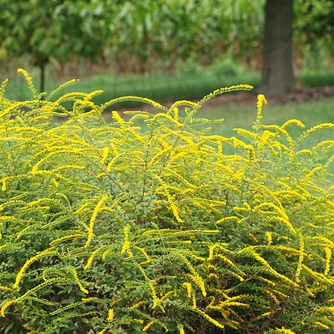By R. Wayne Mezitt
Starting in August and continuing well into autumn, it’s hard to miss the ubiquitous sprays of yellow on roadsides, meadows and other untended sunny sites. The profuse flower-heads of goldenrod vary in color intensity, size and shape; all are yellow-flowering, and depending upon species, their height and spread can be less than a foot tall and wide to more than six feet. Two dozen or more distinct species are native to this region, coming into bloom at differing times, extending the season of color to as much as three months.
Goldenrod (botanical name: Solidago) is a superb pollinator plant. Its protracted flowering season attracts many species of bees, butterflies and other pollinators, making it an ideal choice for native wildflower gardens and meadow plantings. Goldenrod honey is dark and spicy and it has become a popular consumer product with beekeepers. Goldenrod’s diverse flower-plumes also make wonderful, long-lasting cut flowers, particularly in combination with contrasting blooms of other wildflowers.
Until recently, goldenrods were seldom grown as garden plants in the USA. Probably because they are so ingenuous in nature, gardeners in this region consider them to be a “weed”. And that’s not entirely unwarranted: some types can rapidly develop into a problematic garden “thug” due to their propensity to germinate and grow quickly from wind-dispersed seed. Once settled-in for a year or two, removing a heavy clump with its dense mat of roots and rhizomes can be a hefty challenge; and even only a small piece left behind will regrow into a robust plant next season.
But in European gardens, goldenrod has long been favored as an attractive summer-flowering perennial, a major garden feature. Thanks to hybridizing successes, the cultivars and hybrids now coming onto the market are much better suited to our gardens with far better performance attributes and less propensity to spread and dominate. Look for names like ‘Fireworks’, ‘Golden Fleece’, ‘Solar Cascade’ and ‘Golden Baby’ at your local garden center. There’s even a variegated-leaf cultivar of zig-zag goldenrod, Solidago flexicaulis ‘Variegata’, adding its yellow-splashed foliage appeal before the blooms appear.
By now you probably know that goldenrod has been wrongly accused of causing hay fever. That’s because it blooms concurrently and in the same areas with the less conspicuous ragweed, whose pollen is readily carried on the wind. Goldenrod pollen grains are heavy, requiring physical assistance from bees and butterflies to be transported. So spend a few minutes noticing all the goldenrods this season—you may be pleasantly surprised when you take the time to appreciate such a bounty of color and form!







